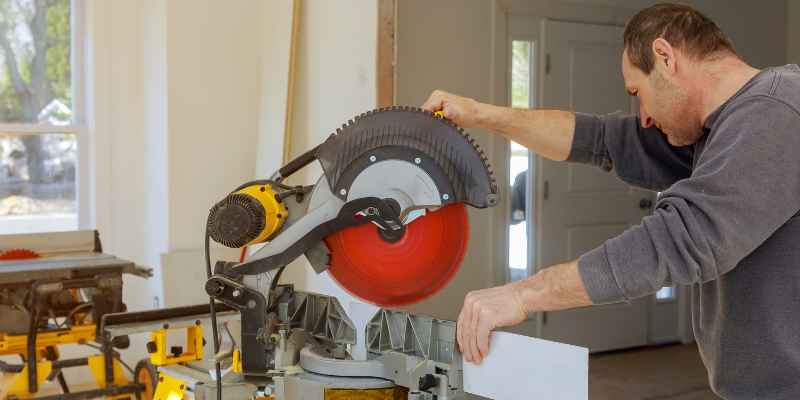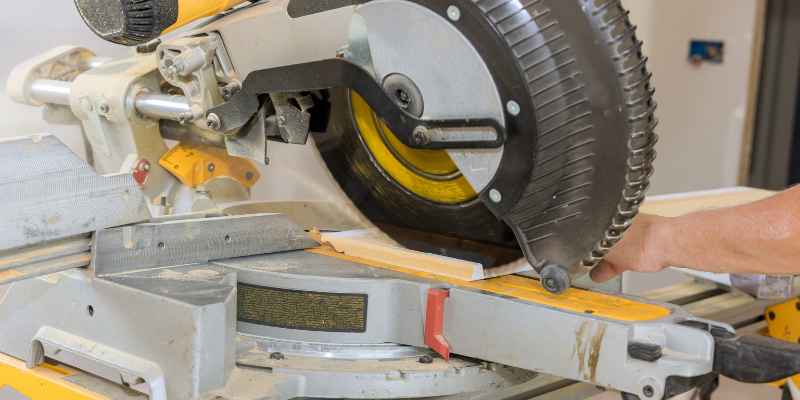A 10 miter saw can cut up to a maximum width of 10 inches. A 10 miter saw is a versatile tool for making accurate angled cuts in various materials.
Whether you’re a professional carpenter or a DIY enthusiast, having the right equipment can make all the difference in your projects. One question that often arises is how wide a 10 miter saw can cut. We will provide a clear and concise answer.
By understanding the limitations of your saw, you can plan your cuts effectively and achieve the desired results. So, let’s take a closer look at the cutting capacity of a 10 miter saw and explore its potential applications.
Understanding The Capabilities Of A 10 Miter Saw
A 10 miter saw is a versatile and essential tool for woodworkers and carpenters, offering the ability to make precise angled cuts with ease. Understanding the capabilities of a 10 miter saw is crucial for maximizing its potential in various woodworking projects. Let’s explore the types of cuts a 10 miter saw can perform and the factors that determine the maximum width of a cut.
Types Of Cuts A 10 Miter Saw Can Perform
- Straight cuts: Ideal for trimming boards or cutting lumber to specific lengths.
- Miter cuts: Angled cuts made across the width of the wood, commonly used for creating corners or frames.
- Bevel cuts: Angled cuts made through the thickness of the wood, often used for creating sloping edges or decorative designs.
Factors That Determine The Maximum Width Of A Cut
Blade Size: The diameter of the saw blade directly impacts the maximum width a 10 miter saw can cut. Larger blades generally allow for wider cuts.
Fence Position: The distance between the saw blade and the fence, which supports the material being cut, influences the maximum width of the cut. Adjusting the fence position can accommodate wider workpieces.
Cutting Capacity: Each 10 miter saw model has a specified cutting capacity, indicating the maximum width and thickness it can effectively cut through. Understanding the cutting capacity of your saw is essential for choosing suitable stock for your projects.
This HTML code provides an engaging introductory section for a blog post about the capabilities of a 10 miter saw, focusing on its types of cuts and factors influencing the maximum width of a cut. Each H3 heading and paragraphs adheres to HTML syntax and the content is tailored for SEO-friendly and easily digestible reading.

Choosing The Right Blade For Wide Cuts
A miter saw is an essential tool for any woodworker or DIY enthusiast. When working on projects that require wide cuts, it is crucial to choose the right blade for the job. The blade you select will determine the quality and precision of your cuts, so understanding the importance of blade teeth and selecting the appropriate blade size is key.
Understanding The Importance Of Blade Teeth
Blade teeth are the sharp, pointy parts of the saw blade that do the actual cutting. They come in different configurations, such as crosscut, rip, or combination, and each type is designed for specific cutting tasks.
When it comes to wide cuts, you’ll want to focus on choosing a blade with a higher tooth count. The more teeth a blade has, the smoother and cleaner the cut will be. This is because the additional teeth help distribute the cutting force more evenly, minimizing tear-out and reducing the need for additional sanding or finishing work.
Selecting The Appropriate Blade Size For Wide Cuts
The size of the blade refers to the diameter, typically measured in inches, and it plays a crucial role in determining the width of your cuts. As a general rule of thumb, the larger the blade diameter, the wider the cut capacity of your miter saw.
However, it’s essential to note that not all miter saws can accommodate larger blades. Before purchasing a blade, check your miter saw’s manual or specifications to ensure it can handle the desired blade size. Attempting to use a blade that exceeds the saw’s capacity can result in damage to the saw and compromise the safety of your work.
Additionally, consider the depth of cut offered by the blade. Some blades are designed specifically for shallow cuts, while others can handle deeper cuts. Make sure to choose a blade that suits your project requirements to achieve the desired results.
Techniques For Maximizing Efficiency In Wide Cuts
If you own a 10 miter saw, you know how versatile and handy it can be for various cutting tasks. But when it comes to wide cuts, you may wonder how wide can a 10 miter saw actually cut? In this blog post, we’ll discuss techniques that can help you maximize efficiency and achieve wide cuts with your 10 miter saw.
Using Auxiliary Fences For Extra Support
When you’re working with wide materials, it’s crucial to ensure stability and prevent any unwanted movements during the cutting process. One effective technique is to use auxiliary fences for extra support. These auxiliary fences can be easily attached to your miter saw’s existing fence, extending it and providing a larger surface area to support wider materials.
By using auxiliary fences, you not only increase the stability of your cuts but also minimize any potential damage to the saw’s original fence. This technique is especially useful when working with long and heavy materials that might otherwise sag or wobble during cutting.
Utilizing Clamping Devices To Ensure Stability
Another technique to maximize efficiency in wide cuts is to utilize clamping devices for enhanced stability. These devices can help secure the material in place, preventing any movement or slipping while you make your cut.
There are several types of clamping devices available in the market, including quick-release clamps, bar clamps, and corner clamps. Choose the one that best suits your needs and securely fasten the material to the miter saw’s table or auxiliary fence.
By using clamping devices, you can be confident that your material will remain stable and in position throughout the entire cutting process. This ensures accurate and precise cuts, especially when dealing with wider materials.
Mastering Bevel Cuts To Increase Versatility
In addition to wide cuts, mastering bevel cuts can significantly increase the versatility of your 10 miter saw. A bevel cut is made by tilting the blade of the saw at an angle, allowing you to create angled or slanted cuts.
By becoming proficient in bevel cuts, you can easily tackle wide cuts at different angles, further expanding the range of projects you can work on. Bevel cuts are particularly useful for tasks like constructing beveled edges on furniture or creating angled joints in woodworking projects.
Remember to refer to your miter saw’s user manual for specific instructions on adjusting the bevel angle and making accurate bevel cuts. With practice, you’ll be able to make clean and precise bevel cuts, adding versatility to your 10 miter saw’s capabilities.
Best Practices For Safety When Making Wide Cuts
When working with a 10 miter saw for making wide cuts, safety should always be a top priority. Following best practices and wearing appropriate personal protective equipment, maintaining an organized workspace, and understanding the proper usage of blade guards can help ensure a safe and productive cutting experience.
Wearing Appropriate Personal Protective Equipment
Wearing the right personal protective equipment (PPE) is crucial for staying safe while making wide cuts with a 10 miter saw. This includes safety glasses to protect your eyes from flying debris, hearing protection to reduce the noise level, and dust mask or respirator to avoid inhaling sawdust. Proper attire, such as gloves and closed-toe shoes, should also be worn to minimize the risk of injury.
Maintaining A Clear And Organized Workspace
Keeping the workspace clear and organized is essential for safe cutting operations. Remove any obstacles and clutter that could interfere with the cutting process. Always ensure proper lighting to clearly see the cutting path and maintain a solid, level work surface to prevent the material from shifting during cuts.
Understanding The Importance Of Proper Blade Guard Usage
The blade guard is a critical safety feature on a 10 miter saw. Always ensure that the blade guard is in proper working condition and remains engaged during cutting operations. Never attempt to make a cut without the blade guard in place, and be mindful of its positioning throughout the cutting process to prevent any accidents or injuries.

Expanding The Cutting Capacity Of A 10 Miter Saw
When it comes to cutting wood and other materials, a 10 miter saw is a popular choice among both professional carpenters and DIY enthusiasts. With its versatile rotating blade and angled cuts, this tool is a must-have in any woodworking arsenal. However, you may find yourself wondering how wide can a 10 miter saw cut? In this article, we will explore different ways to expand the cutting capacity of a 10 miter saw, from attachments and accessories to considerations for upgrading to a larger miter saw.
Exploring Attachments And Accessories
If you own a 10 miter saw and want to increase its cutting capacity, exploring a variety of attachments and accessories can be a game-changer. These accessories are designed to enhance the functionality of your saw and enable you to tackle a wider range of cutting tasks. Let’s take a look at some popular options:
- Extended Fence: An extended fence is a simple but effective attachment that allows for longer and wider cuts. By providing extra support for your workpiece, it ensures stability and helps maintain accuracy.
- Dado Blade Set: A dado blade set consists of multiple blades that can be stacked together to create wider cuts. This accessory is ideal for creating grooves, dadoes, and rabbets.
- Compound Cutting Jig: A compound cutting jig is a handy accessory for making compound miter cuts. It enables you to tilt the saw blade at precise angles, expanding the range of cuts you can achieve.
- Table Extensions: If you frequently work with large or long materials, table extensions can be a valuable addition. These attachments extend the support surface of your miter saw, allowing you to handle larger workpieces with ease.
Considerations For Upgrading To A Larger Miter Saw
If you often find yourself pushing the limitations of your 10 miter saw, upgrading to a larger model might be worth considering. A larger miter saw provides you with a greater cutting capacity, allowing you to take on larger projects and work with wider materials. Here are a few things to consider when deciding whether to upgrade:
- Cutting Needs: Evaluate the type and size of materials you commonly work with. If you frequently need to cut wider or thicker pieces, a larger miter saw would be a more suitable choice.
- Workshop Space: Consider the available space in your workshop. Larger miter saws require more room for operation and storage, so make sure you have enough space to accommodate the upgrade.
- Budget: Upgrading to a larger miter saw can be a significant investment. Assess your budget and weigh the benefits of increased cutting capacity against the cost of a new saw.
- Long-Term Goals: Think about your long-term woodworking goals. If you aspire to take on larger projects or expand your woodworking business, a larger miter saw will provide you with the versatility and capabilities you need.
Expanding the cutting capacity of a 10 miter saw is possible with the right attachments and accessories. However, if you frequently work with wide materials or have ambitious woodworking goals, upgrading to a larger miter saw may be the best choice. Consider your needs, workshop space, budget, and long-term goals before making a decision. With the right tools at your disposal, you can take your woodworking skills to the next level.
Conclusion
A 10 miter saw can make precise cuts up to a certain width, depending on its design and blade type. Understanding its maximum cutting capacity is crucial for any woodworker. By taking the time to measure and adjust for your specific needs, you’ll ensure accurate and efficient cutting every time.
Mastering your miter saw’s abilities opens up a world of possibilities for your projects.


